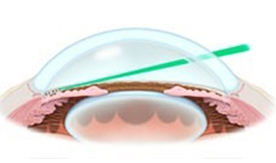Symptoms and Signs
Glaucoma refers to a group of eye disorders that usually have few or no initial symptoms and eventually cause harm to the optic nerve that carries information from the eye to the brain. In most cases, glaucoma is associated with higher-than-normal pressure inside the eye (ocular hypertension). If untreated or uncontrolled, glaucoma first causes peripheral vision loss and eventually can lead to blindness.
Glaucoma has been referred to as the "sneak thief of sight" since vision loss occurs overs many years without any obvious symptoms until late in the disease process. Routine eye exams are imperative to detect glaucoma in its early stages and therapy can started to prevent loss of vision. Normal eye pressure is between 10 and 21 mmHg. If eye pressure is above 21 mmHg then damage can occur to the optic nerve. Peripheral vision is lost in the early and moderate stages of glaucoma but if not treated glaucoma can result in total blindness. Risk factors for glaucoma include high eye pressure, family history of glaucoma, African-American heritage, diabetes, near-sightedness, age greater than forty and high blood pressure.
Treatment
If detected in its early stages glaucoma can usually be controlled with medications- typically in the form of eye drops. Fortunately, there is a wide variety of eye medications available to treat glaucoma. If medications are not effective the next option is usually laser surgery. This surgery is call laser trabeculoplasty and is performed in the office. Trabeculoplasty is a safe, non-invasive procedure that takes less than five minutes.
If medications and laser surgery are not successful then surgery in the operating room might be necessary. Options for glaucoma surgery include MIGS procedures, trabeculectomy or Ahmed Valves. MIGS procedures are the most recent surgical options for glaucoma. MIGS is short for Minimally Invasive Glaucoma Surgery and involves the insertion of very small stents (tubes) within the eye to lower eye pressure. Multiple MIGS stents are available and at the current time Dr. Teague is implanting the iStent, Hydrus stent and the Xen stent. Each stent has it's particular advantages/disadvantages. In some cases MIGS stents may not be the best option and trabeculectomy might be necessary. Trabeculectomy involves the formation of a drainage filter in the eye to reduce eye pressure using the natural tissues of the eye. Ahmed Valves are usually the last option for the surgical treatment of glaucoma. Ahmed Valves consist of a tube implanted in front of the iris/pupil of the eye which is connect to a plastic plate which is sutured to the top of the eye.
We are well qualified for all your glaucoma needs. Dr. Teague was the first fellowship-trained glaucoma specialist in the Big Country and has performed glaucoma surgeries for almost thirty years.

Glaucoma Vision

Laser Trabeculoplasty


